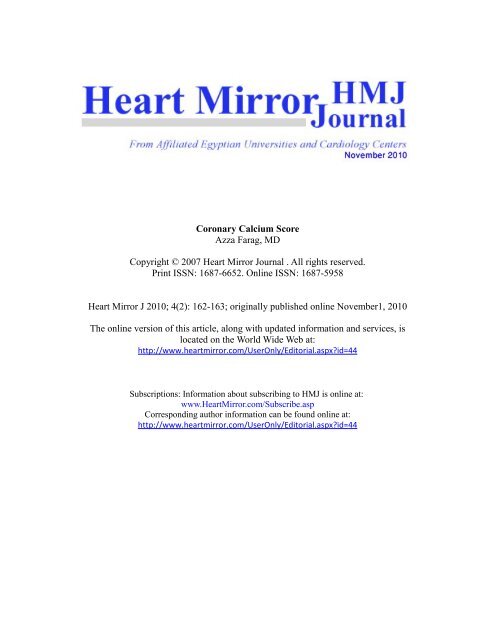Coronary Calcium Score Azza Farag, MD ... - HeartMirror.com
Coronary Calcium Score Azza Farag, MD ... - HeartMirror.com
Coronary Calcium Score Azza Farag, MD ... - HeartMirror.com
You also want an ePaper? Increase the reach of your titles
YUMPU automatically turns print PDFs into web optimized ePapers that Google loves.
<strong>Coronary</strong> <strong>Calcium</strong> <strong>Score</strong><br />
<strong>Azza</strong> <strong>Farag</strong>, <strong>MD</strong><br />
Copyright © 2007 Heart Mirror Journal . All rights reserved.<br />
Print ISSN: 1687-6652. Online ISSN: 1687-5958<br />
Heart Mirror J 2010; 4(2): 162-163; originally published online November1, 2010<br />
The online version of this article, along with updated information and services, is<br />
located on the World Wide Web at:<br />
http://www.heartmirror.<strong>com</strong>/UserOnly/Editorial.aspx?id=44<br />
Subscriptions: Information about subscribing to HMJ is online at:<br />
www.<strong>HeartMirror</strong>.<strong>com</strong>/Subscribe.asp<br />
Corresponding author information can be found online at:<br />
http://www.heartmirror.<strong>com</strong>/UserOnly/Editorial.aspx?id=44
Vol. 4, No. 2, 2010<br />
Sep 2010: 157-169<br />
Mini-Reviews<br />
162<br />
9. Dorros G, Jaff M, Mathiak L, et al. Multicenter Palmaz stent renal<br />
artery stenosis revascularization registry report: Four-year followup<br />
of 1,058 successful patients. Catheter Cardiovasc Interv 2002;<br />
55(2):182-8.<br />
10. Levy MS, Creager MA. Revascularization versus medical therapy<br />
for renal-artery stenosis. The ASTRAL investigators. The New<br />
England Journal of Medicine 2009; 361: 1953-1962. Vasc Med<br />
2010; 15(4):343-5.<br />
11. Collins R, Peto R, Gray R, et al. Large-scale randomized evidence:<br />
Trials and overviews. In: Weatherall DJ, Ledingham JGG, Warrell<br />
DA, editors. Oxford textbook of medicine. 3rd ed. Oxford, UK:<br />
Oxford University Press; 1996. p. 21-32.<br />
12. Leertouwer TC, Gussenhoven EJ, Bosch JL, et al. Stent placement<br />
for renal arterial stenosis: Where do we stand? A meta-analysis.<br />
Radiology 2000; 216(1):78-85.<br />
13. Chrysochou C, Sinha S, Chalmers N, et al. Anuric acute renal failure<br />
and pulmonary oedema: A case for urgent action. Int J Cardiol 2009;<br />
132(1):e31-3.<br />
3. <strong>Coronary</strong> <strong>Calcium</strong> <strong>Score</strong><br />
<strong>Azza</strong> <strong>Farag</strong>, <strong>MD</strong><br />
Abbreviations and Acronyms<br />
EBCT : Electron Beam Computed Tomography<br />
<strong>MD</strong>CT : Multidetector Computed Tomography<br />
<strong>Coronary</strong> artery disease (CAD) is currently, and will<br />
remain for the foreseeable future, the leading cause of<br />
death and disability worldwide. Although effective plans<br />
and tools are available for treating and delaying CAD<br />
progression, treatments are underutilized because at risk<br />
individuals are not easily identified. To date, in excess of<br />
300 risk factors for CAD have been identified; however,<br />
most of these are not independent of each other and the<br />
number of truly independent risk factors remains small (1).<br />
<strong>Coronary</strong> <strong>Calcium</strong> <strong>Score</strong>:<br />
It is generally accepted that the presence of coronary<br />
calcium correlates directly with coronary atherosclerotic<br />
plaque burden and its detection is an established technique<br />
for cardiovascular risk assessment (2). Its presence per<br />
se as detected by electron beam <strong>com</strong>puted tomography<br />
(EBCT) or multidetector <strong>com</strong>puted tomography (<strong>MD</strong>CT)<br />
is significantly associated with incident cardiovascular<br />
disease events independent of the traditional risk factors<br />
such as blood pressure, plasma glucose level and cholesterol<br />
levels (3, 4). But does the amount of this calcium could<br />
independently predict adverse cardiac events, is still yet<br />
not clear.<br />
<strong>Calcium</strong> accumulates in the coronary arteries in an<br />
age-related manner, and the accumulation appears to be<br />
exponential because calcium continuously deposited in<br />
pre-existing lesion; thus all scores must be adjusted for age<br />
as well as for sex. Modification of the Framingham Risk<br />
Chart variable (chronologic age) by a non-chronometric<br />
variable (biologic age) which is the degree of calcium in<br />
the coronary tree is a debatable issue. However, the concept<br />
allows for a re-definition of conceived risk and might serve<br />
for treatment decisions in primary prevention in subjects<br />
with intermediate risk. The more the calcium be<strong>com</strong>es<br />
apparent, the older is the coronary lesion in a given patients<br />
and the higher is his subsequent risk (5).<br />
It is important to report that coronary calcium scoring<br />
examination does not define the location or severity of any<br />
particular lesion and it is not substitute for the physiological<br />
stress testing or angiography. Individuals with calcium<br />
score over 10, have coronary heart disease and should<br />
receive treatment to reduce the LDL cholesterol to less than<br />
100 mg% as specified in the ATP III guidelines (6). Repeat<br />
scans are suggested every one or two years to monitor<br />
treatment response. Patients with score over 400 should be<br />
considered for further evaluation to rule out an obstructive<br />
lesion with an exercise or pharmacologic stress test.<br />
These patients are at increased risk for the development of<br />
symptomatic cardiac disease (4.8% per year). Individuals<br />
with symptomatic angina and calcium score >400 have an<br />
extremely high (~15% per year) cardiac event rate (2).<br />
Extracoronary Calcification:<br />
It is well established that atherosclerotic vascular<br />
disease is a diffuse process, thus explaining the association<br />
between coronary and extra-coronary atherosclerosis (7).<br />
Recently, few studies involve extracoronary cardiac<br />
calcification mainly the aortic valve, mitral annulus and<br />
thoracic aorta in the risk profile of patients with suspected<br />
coronary artery disease (7-10). The presence of aortic<br />
valve calcium has been shown to be an independent<br />
predictor of advanced coronary artery disease (7) as well<br />
as carotid stenosis (11) reflecting the atherosclerotic<br />
burden rather than just a degenerative change (12). The<br />
prevalence of three-vessel obstructive coronary artery<br />
disease is approaching 50% in patients with mitral annular<br />
calcification (13).<br />
Although, presence and severity of calcification in the<br />
coronaries has been clearly established as an indicator for<br />
an adverse cardiovascular out<strong>com</strong>e, the prognostic value of<br />
extracoronary cardiac calcification remained not entirely<br />
clear. It is imperative that the independent prognostic value<br />
of these markers for future events of coronary as well as<br />
non-coronary vascular tree (stroke, peripheral vascular<br />
disease) needs to be asserted (14).<br />
Downloaded from www.heartmirror.<strong>com</strong>
163<br />
Mini-Reviews<br />
Vol. 4, No. 2, 2010<br />
Sep 2010: 157-169<br />
Corresponding Author<br />
<strong>Azza</strong> <strong>Farag</strong>, <strong>MD</strong><br />
Cardiology Department, Cairo University, Egypt<br />
E-mail: azzzabdelmoniem@yahoo.<strong>com</strong><br />
REFERENCES<br />
1. http://newportbodyscan.<strong>com</strong>/TheHeartScan.shtm<br />
2. O'Rourke RA, Brundage BH, Froelicher VF, et al. American<br />
College of Cardiology/American Heart Association Expert<br />
Consensus Document on electron-beam <strong>com</strong>puted tomography for<br />
the diagnosis and prognosis of coronary artery disease. J Am Coll<br />
Cardiol 2000; 36(1):326-40.<br />
3. Kondos GT, Hoff JA, Sevrukov A, et al. Electron-beam tomography<br />
coronary artery calcium and cardiac events: A 37-month follow-up<br />
of 5635 initially asymptomatic low- to intermediate-risk adults.<br />
Circulation 2003; 107(20):2571-6.<br />
4. Raggi P, Shaw LJ, Berman DS, et al. Prognostic value of coronary<br />
artery calcium screening in subjects with and without diabetes. J Am<br />
Coll Cardiol 2004; 43(9):1663-9.<br />
5. Grundy SM. <strong>Coronary</strong> plaque as a replacement for age as a risk<br />
factor in global risk assessment. Am J Cardiol 2001; 88(2A):<br />
8E-11E.<br />
6. Expert Panel on Detection, Evaluation, and Treatment of High Blood<br />
Cholesterol in Adults. Executive Summary of The Third Report of<br />
The National Cholesterol Education Program (NCEP) Expert Panel<br />
on detection, evaluation and treatment of high blood cholesterol in<br />
adults (Adult Treatment Panel III). JAMA 2001; 285(19):2486-97.<br />
7. Yamamoto H, Shavelle D, Takasu J, et al. Valvular and thoracic<br />
aortic calcium as a marker of the extent and severity of angiographic<br />
coronary artery disease. Am Heart J 2003; 146(1):153-9.<br />
8. Allison MA, Cheung P, Criqui MH, et al. Mitral and aortic<br />
annular calcification are highly associated with systemic calcified<br />
atherosclerosis. Circulation 2006; 113(6):861-6.<br />
9. Adler Y, Fisman EZ, Shemesh J, et al. Spiral <strong>com</strong>puted tomography<br />
evidence of close correlation between coronary and thoracic aorta<br />
calcifications. Atherosclerosis 2004; 176(1):133-8.<br />
10. Wong ND, Sciammarella M, Arad Y, et al. Relation of thoracic<br />
aortic and aortic valve calcium to coronary artery calcium and risk<br />
assessment. Am J Cardiol 2003; 92(8):951-5.<br />
11. Adler Y, Levinger U, Koren A, et al. Relation of nonobstructive<br />
aortic valve calcium to carotid arterial atherosclerosis. Am J Cardiol<br />
2000; 86(10):1102-5.<br />
12. Watanabe K, Hiroki T, Koga N. Relation of thoracic aorta<br />
calcification on <strong>com</strong>puted tomography and coronary risk factors<br />
to obstructive coronary artery disease on angiography. Angiology<br />
2003; 54(4):433-41.<br />
13. Adler Y, Herz I, Vaturi M, et al. Mitral annular calcium detected by<br />
transthoracic echocardiography is a marker for high prevalence and<br />
severity of coronary artery disease in patients undergoing coronary<br />
angiography. Am J Cardiol 1998; 82(10):1183-6.<br />
14. Nasir K, Katz R, Takasu J, et al. Ethnic differences between extracoronary<br />
measures on cardiac <strong>com</strong>puted tomography: Multi-<br />
Ethnic Study of Atherosclerosis (MESA). Atherosclerosis 2008;<br />
198(1):104-14.<br />
4. The Burden of Atrial Fibrillation<br />
Aly Zaki, <strong>MD</strong>, MRCP<br />
Abbreviations and Acronyms<br />
ACE-I : Angiotensin converting enzyme inhibitors.<br />
AF: Atrial fibrillation.<br />
ATHENA: Effect of dronaderone on cardiovascular<br />
out<strong>com</strong>es in high risk patients with atrial fibrillation or<br />
atrial flutter study.<br />
COCAF : Cost of Care Distribution in Atrial Fibrillation<br />
patients study.<br />
CRT : Cardiac resynchronization therapy.<br />
CV : Cardiovascular<br />
ICD : Internal cardiovertor defibrillator.<br />
NYHA : New York Heart Association<br />
PCI : Percutaneous coronary intervention.<br />
QOL : Quality of life<br />
RFA : Radiofrequency ablation<br />
TE : Thromboembolism/thromboembolic<br />
TRENDS: The relationship between daily atrial<br />
tachyarrhythmia burden from implantable device<br />
diagnostics and stroke risk study.<br />
Despite a plethora of medications and procedures<br />
used in the treatment and prevention of atrial fibrillation<br />
(AF), morbidity and mortality related to the arrhythmia<br />
remain substantial. AF poses a significant burden on<br />
the quality of life of patients as well on the resources of<br />
<strong>com</strong>munities and healthcare providers. From the patients’<br />
perspective, the symptomatic burden of the arrhythmia<br />
often significantly impacts the quality of life. The<br />
economic burden of treating and caring for patients with<br />
AF, including treatment of related <strong>com</strong>plications is both<br />
costly and <strong>com</strong>plex, often requiring specialist medical<br />
care, hospitalization and interventional procedures. This<br />
article briefly reviews the epidemiologic, temporal and<br />
symptomatic burden of AF and the consequent economic<br />
burden imposed by this prevalent arrhythmia.<br />
Epidemiologic, Morbidity and Mortality Burden:<br />
Atrial fibrillation is the <strong>com</strong>monest sustained<br />
arrhythmia with an overall prevalence reported between<br />
1 and 6% in the general population (1-3). Prevalence<br />
rises to approximately 10% in those older than 80 years<br />
and 15% for those over 90 years old, and data from the<br />
Framingham Heart study estimate that 1 in 4 people above<br />
the age of 40 will have AF at some point in their lives (1).<br />
Furthermore, the reported prevalence of AF may actually<br />
be underestimated seeing as sustained silent AF is likely<br />
more <strong>com</strong>mon than previously thought. Indeed, modern<br />
implantable devices such as pacemakers and ICDs show<br />
that up to 50-60% of people older than 65 years have silent<br />
Downloaded from www.heartmirror.<strong>com</strong>



